Borzoi
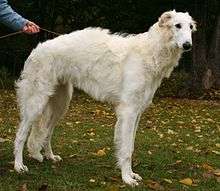 A Borzoi | |||||||||||||||||||||||||||||||||
| Other names |
Barzoï Russian Wolfhound Russian Hunting Sighthound Russkaya Psovaya Borzaya | ||||||||||||||||||||||||||||||||
|---|---|---|---|---|---|---|---|---|---|---|---|---|---|---|---|---|---|---|---|---|---|---|---|---|---|---|---|---|---|---|---|---|---|
| Origin | Russia | ||||||||||||||||||||||||||||||||
| |||||||||||||||||||||||||||||||||
| |||||||||||||||||||||||||||||||||
| Domestic dog (Canis lupus familiaris) | |||||||||||||||||||||||||||||||||
The Borzoi (/ˈbɔːrzɔɪ/, literally "fast"), also called the Russian wolfhound (Russian: Ру́сская псовая борзая), is a breed of domestic dog (Canis lupus familiaris). Descended from dogs brought to Russia from central Asian countries, it is similar in shape to a greyhound, and is also a member of the sighthound family.
The system by which Russians over the ages named their sighthounds was a series of descriptive terms, not actual names. "Borzói" is the masculine singular form of an archaic Russian adjective that means "fast". "Borzáya sobáka" ("fast dog") is the basic term used by Russians, though "sobáka" is usually dropped. The name "Psovaya" derived from the word Psovina, which means "wavy, silky coat", just as "Hortaya" (as in Hortaya Borzaya) means shorthaired. In Russia today the breed we know as the borzoi is officially known as "Russkaya Psovaya Borzaya". Other Russian sighthound breeds are "Stepnaya Borzaya" (from the steppe), called "Stepnoi"; and "Krimskaya Borzaya" (from the Crimea), called "Krimskoi".
The most commonly used plural form is the regular formation "borzois", which is the only plural cited in most dictionaries.[1][2] However, the Borzoi Club of America and the Borzoi Club UK[3] both prefer "borzoi" as the form for both singular and plural forms.
Description
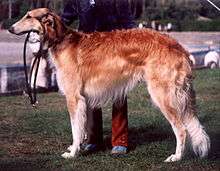
Appearance
Borzois are large Russian sighthounds that resemble some central Asian breeds such as the Afghan hound, Saluki, and the Kyrgyz Taigan. Borzois can generally be described as "long-haired greyhounds". Borzois come in virtually any colour.[4] The borzoi coat is silky and flat, often wavy or slightly curly. The long top-coat is quite flat, with varying degrees of waviness or curling. The soft undercoat thickens during winter or in cold climates, but is shed in hot weather to prevent overheating. In its texture and distribution over the body, the borzoi coat is unique. There should be a frill on its neck, as well as feathering on its hindquarters and tail.[5]
Borzoi males frequently weigh more than 100 pounds (45 kg). Males stand at least 30 inches (76 cm) at the shoulder, while the height of females is around 26 inches (66 cm). Despite their size, the overall impression is of streamlining and grace, with a curvy shapeliness and compact strength.
 A black borzoi
A black borzoi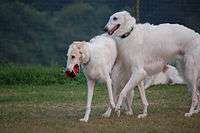 White borzois
White borzois Black and white Borzoi
Black and white Borzoi White with brown coated Borzoi
White with brown coated Borzoi
Temperament

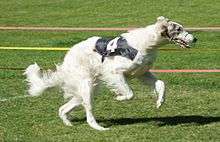
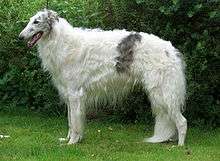
The borzoi is a quiet, but athletic and independent dog. Most borzois are almost silent, barking only very rarely. They do not have strong territorial drives and cannot be relied on to raise the alarm upon sighting a human intruder. The borzoi is extremely smart and requires patient, experienced handling. They are gentle and highly sensitive dogs with a natural respect for humans, and as adults they are decorative couch potatoes with remarkably gracious house manners. Borzois do not generally display dominance or aggression towards people, but will turn aggressive if handled roughly. Typically however, they are rather reserved with strangers but affectionate with people they know well. Their sensitivity to invasion of their personal space can make them nervous around children unless they are brought up with them. Despite their size, borzois adapt very well to suburban life, provided they have a spacious yard and regular opportunities for free exercise.
A common misunderstanding about the intelligence of breeds in the Hound group stems from their independent nature, which conflicts with the frequent confusion between the concepts of "intelligence" and "obedience" in discussions of canine brainpower. Stanley Coren's survey of canine obedience trainers published in The Intelligence of Dogs reported that borzois obeyed the first command less than 25% of the time. Coren's test, however, was by his own admission heavily weighted towards the "obedience" interpretation of intelligence and based on a better understanding of "working" breeds than hounds. Unfortunately, the publicity given to this report has led to unfair denigration of breeds which are under-represented in obedience clubs and poorly understood by the average obedience trainer.[6] "Work" for hound breeds is done out of hearing and often out of sight of the human companion; it is an activity for which the dogs are "released", rather than an activity which is "commanded".
In terms of obedience, borzois are selective learners who quickly become bored with repetitive, apparently pointless, activity, and they can be very stubborn when they are not properly motivated. For example, food rewards, or "baiting", may work well for some individuals, but not at all for others. Nevertheless, borzois are definitely capable of enjoying and performing well in competitive obedience and agility trials with the right kind of training.[7][8][9] Like other sighthounds, they are very sensitive and do not cope well with harsh treatment or training based on punishment, and will be extremely unhappy if raised voices and threats are a part of their daily life. However, like any intelligent dog, borzois respond extremely well to the guidance, support, and clear communication of a benevolent human leadership.
Borzois were bred to pursue or "course" game and have a powerful instinct to chase things that run from them, including cats and small dogs.[10] Built for speed and endurance, they can cover long distances in a very short time. A fully fenced yard is a necessity for maintaining any sighthound. They are highly independent and will range far and wide without containment, with little regard for road traffic. For off-leash exercise, a borzoi needs a very large field or park, either fully fenced or well away from any roads, to ensure its safety.
Borzois are born with specialized coursing skills, but these are quite different from the dog-fighting instincts seen in some breeds. It is quite common for borzois at play to course (i.e., run down) another dog, seize it by the neck and hold it immobile. Young pups do this with their littermates, trading off as to who is the prey. It is a specific hunting behavior, not a fighting or territorial domination behavior.
Borzois can be raised very successfully to live with cats and other small animals provided they are introduced to them when they are puppies. Some, however, will possess the hunting instinct to such a degree that they find it impossible not to chase a cat that is moving quickly. The hunting instinct is triggered by movement and much depends on how the cat behaves.
Health

Stated life expectancy is 10 to 12 years.[11][12] Median lifespan based on a UK Kennel Club survey is 9 years 1 month. 1 in 5 died of old age, at an average of 10 to 11.5 years. The longest lived dog lived to 14 years 3 months.[13] Dogs that are physically fit and vigorous in their youth through middle age are more vigorous and healthy as elderly dogs, all other factors being equal. In the UK, cancer and cardiac problems seem to be the most frequent causes of premature death.[14]
Like its native relative the Hortaya Borzaya, the borzoi is basically a very sound breed. OCD, hip and elbow dysplasia have remained almost unknown, as were congenital eye and heart diseases before the 1970s. However, in some countries modern breeding practices have introduced a few problems.
As with other very deep-chested breeds, gastric torsion is the most common serious health problem in the borzoi. Also known as bloat, this life-threatening condition is believed to be anatomical rather than strictly genetic in origin. One common recommendation in the past has been to raise the food bowl of the dog when it eats. However, studies have shown that this may actually increase the risk of bloat.[15]
Less common are cardiac problems including cardiomyopathy and cardiac arrhythmia disorders. A controversy exists as to the presence of progressive retinal atrophy in the breed. A condition identified as borzoi retinopathy is seen in some individuals, usually active dogs, which differs from progressive retinal atrophy in several ways. First, it is unilateral, and rarely seen in animals less than three years of age; second, a clear-cut pattern of inheritance has not been demonstrated; and finally, most affected individuals do not go blind.
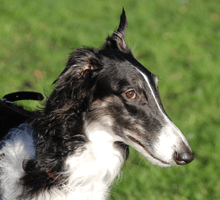
Correct nutrition during puppyhood is also debatable for borzois. These dogs naturally experience enormous growth surges in the first year or two of their lives. It is now widely accepted that forcing even faster growth by feeding a highly concentrated, high-energy diet is dangerous for skeletal development, causing unsoundness and increased tendency to joint problems and injury. Being built primarily for speed, borzois do not carry large amounts of body fat or muscle, and therefore have a rather different physiology to other dogs of similar size (such as the Newfoundland, St. Bernard, or Alaskan Malamute). Laboratory-formulated diets designed for a generic "large" or "giant" breed are unlikely to take the needs of the big sighthounds into account.
The issues involved in raw feeding may be particularly relevant to tall, streamlined breeds such as the borzoi. It is interesting to note that the Hortaya Borzaya, undoubtedly a very close relative, is traditionally raised on a meager diet of oats and table scraps. The Hortaya is also said to be intolerant of highly concentrated kibble feeds. Basically, a lean body weight in itself is nothing to be concerned about, and force-feeding of healthy young borzoi is definitely not recommended.
History

_Wolf_hunt_with_borzois.jpg)

It was long thought that Saluki type sighthounds were originally brought to Russia from Byzantium in the South about the 9th and 10th centuries and again later by the Mongol invaders from the East. However, now that the archeological archives and research results of the former USSR are open to scientists, it has become quite clear that the primal sighthound type evolved between the Kyrgyzstan, the lower Kazakhstan part of Altai and the Afghan plains, and that the earliest actual sighthound breeds were the plains Afghan hounds and the Kyrgyz Taigan.
These ancient breeds then migrated South (founding the Tazi/Saluki branch) and West (founding the Stepnaya, Krimskaya and Hortaya branches) to develop into breeds adapted to those regions. This was a slow process which happened naturally through normal spreading of trade, with the silk and spice trade via the Silk Road being the prime vector.
The more modern Psovaya Borzaya was founded on Stepnaya, Hortaya and the Ukrainian-Polish version of the old Hort. There were also imports of Western sighthound breeds to add to the height and weight. It was crossed as well with the Russian Laika specifically and singularly to add resistance against Northern cold and a longer and thicker coat than the Southern sighthounds were equipped with.
All of these foundation types—Tazi, Hortaya, Stepnaya, Krimskaya, and Hort—already possessed the instincts and agility necessary for hunting and bringing down wolves.
The Psovoi was popular with the Tsars before the 1917 revolution. For centuries, Psovoi could not be purchased but only given as gifts from the Tsar. Grand Duke Nicholas Nicolaievich of Russia bred countless Psovoi at Perchino, his private estate.[16]
The Russian concept of hunting trials was instituted during the era of the Tsars. As well as providing exciting sport, the tests were used for selecting borzoi breeding stock; only the quickest and most intelligent hunting dogs went on to produce progeny. For the aristocracy these trials were a well-organized ceremony, sometimes going on for days, with the borzois accompanied by mounted hunters and Foxhounds on the Russian steppe. Hares and other small game were by far the most numerous kills, but the hunters especially loved to test their dogs on wolf. If a wolf was sighted, the hunter would release a team of two or three borzois. The dogs would pursue the wolf, attack its neck from both sides, and hold it until the hunter arrived. The classic kill was by the human hunter with a knife. Wolf trials are still a regular part of the hunting diploma for all Russian sightdog breeds of the relevant type, either singly or in pairs or trios, in their native country.
After the 1917 Revolution, wolf hunting with sighthounds has soon gone out of fashion as an "aristocratic" and a means- and -time-taking way of hunting. A necessity in a wolf-catching sighthound didn't exist, in addition to the old proved technique of batue with the use of baits, flags and other appeared new, way more effective—from airplanes, from propeller sleighs, with electronic lure whistles. For decades the generations of few remaining sighthounds were regarded as hunting-suited, when showing enough attacking initiative for fox hunting. The rumours about prosecution of sighthounds in post-revolutionary Russia is a legend of modern time, possibly based on similar incidents in Maoist China.
In the late 1940s, a Soviet soldier named Constantin Esmont made detailed records of the various types of borzoi he found in Cossack villages. Esmont's illustrations were recently published and can be viewed by clicking on the link below.
Esmont was concerned that the distinct types of borzaya were in danger of degenerating without a controlled system of breeding. He convinced the Soviet government that borzois were a valuable asset to the hunters who supported the fur industry and henceforth, their breeding was officially regulated. To this day short-haired Hortaya Borzaya are highly valued hunting dogs on the steppes, while the long-haired Psovaya Borzaya, is going through a hard period of restoration of its working qualities after decades of shadow, mainly show existence.
Exports of borzois to other countries were extremely rare during the Soviet era. However, enough had been taken to England, Scandinavia, Western Europe, and America in the late 19th century for the breed to establish itself outside its native country.
Notable borzois

- The borzoi is the symbol of Alfred A. Knopf publishing house.
- Tasha, a female borzoi belonging to the noted vet Buster Lloyd-Jones (founder of Denes natural pet foods), was born in the UK during the Second World War and is the pedigree ancestor of most British borzoi bloodlines.[17]
- Ben was the white male borzoi, beloved of Edward J. Smith, Captain of the Titanic. There exists a photo of the Captain and his dog outside his cabin on the ship. The dog was not, however, on the maiden voyage.
- Kolchak has been the mascot of the 27th Infantry Regiment since the Regiment participated in the Siberian Intervention. The 27th Infantry had been nicknamed "The Wolfhounds" in recognition of their endurance during battles in Siberia.
- In the late 1960s President of Finland, Urho Kekkonen received two borzois, Ludmila and Leo from the Soviet Union.
In popular culture

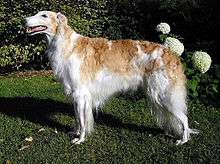
- Leo Tolstoy's 1869 novel War and Peace contains an extensive wolf hunting scene with borzois in book 7, chapters 3 to 6.[18]
- F. Scott Fitzgerald's second novel, The Beautiful and Damned (1922), contains a scene in which Gloria compares Anthony to a Russian wolfhound. Anthony decides to take this as a compliment: "Anthony remembered that they were white and always looked unnaturally hungry. But then they were usually photographed with dukes and princesses, so he was properly flattered."[19]
- George Bernard Shaw in his Everybody’s Political What’s What?(1944) wrote "The future of mankind belongs to its mongrels and not to its handsome but brainless Borzois."
- Ivan, one of the protagonists of the historical novel by the Cuban writer Leonardo Padura Fuentes, El hombre que amaba a los perros (The Man Who Loved Dogs), is the editor of a university journal of veterinary medicine, who manages to make a living during the Special Period in Cuba by helping people take care of their dogs. The novel alludes to Ivan's own dogs as well as to borzoi dogs owned by Leon Trotsky and his assassin, Ramón Mercader.
- In the book Dark Symphony (2003) by Christine Feehan, Byron gives Antonietta a black borzoi named "Celt".
- In the book The Romanov Prophecy (2004) by Steve Berry
- In the anime Kuroshitsuji (Japanese for Black Butler), Ciel Phantomhive as a child had a black borzoi named Sebastian. He named the demon with which he made a Faustian contract after this dog.
- The 1968 film version War and Peace contains a hunting scene with borzois from the kennel of Ekhaga, Sweden.
- Uncle Zeke starred as "Digger" in the 2000 Disney film, 102 Dalmatians
- The borzoi brothers, Rocket, Missile, and Jet in Ginga Densetsu Weed
- Boris in Walt Disney's 1955 film Lady and the Tramp
- D'or's Prince Igor owned by Barbara Todd (Zcerlov) and bred by Andre Legere appears in the 1969 film, Hello Dolly!
- When Katniss Everdeen and Peeta Mellark arrive at the Capitol in the 2012 film The Hunger Games, a pair of pink borzois are shown on screen—an illustration of the Capitol residents' gaudy lifestyle.[20]
- Borzois can also been seen in cameo roles in the films Love at First Bite, Legends of the Fall ("Notchee Boy"),[21] Excalibur, All Dogs Go to Heaven (1989), Bride of Frankenstein, Easter Parade, Wolfen, Ziegfeld Follies, Onegin (1999), Gangs of New York (2002), Chaplin, The Avengers (TV series), JAG, Maverick (1994), Sleepy Hollow, Last Action Hero, and A Knights Tale (on the DVD deleted scenes).
- "Mademoiselle Nobs" from Pink Floyd: Live at Pompeii (1971) who "sings" a song with the band.[22][23]
- Lyndell Ackerman's "Nessie" CH Windyglens Finesse in the TV show Wings.
- In an SCTV parody commercial for fictional Poochare dog food, a borzoi dog is seen being taken for a walk by Eugene Levy.
- In episode 2 of the first season of the anime Medaka Box, one of the requests for the student council is to find a missing puppy, which turns out to be a borzoi. It has grown quite large since it was lost. This also happens in the manga version.
- A borzoi is one of the dogs to appear in the film Cats & Dogs. It is seen during the council session scene.
In art
In 2004, the UK Kennel Club held its fourth temporary exhibition, "The Borzoi in Art," which offered unique insights into the borzoi and how the breed has been depicted in art throughout the 19th and 20th centuries. The exhibition included paintings, bronzes, and porcelain which had previously not been available to the public. The exhibition ran from 27 September to 3 December. The borzoi is frequently found in art deco-period works.
Gallery
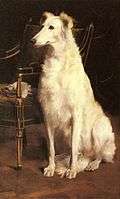 A Borzoi by a Chair, by George Hare
A Borzoi by a Chair, by George Hare Die Suffragette
Die Suffragette.jpg) Louis Vorow Zborrowski by Julian Russell Story (1857-1919)
Louis Vorow Zborrowski by Julian Russell Story (1857-1919) George Barbier depicting a woman with a Borzoi in La Gazette
George Barbier depicting a woman with a Borzoi in La Gazette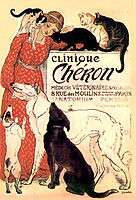
 A Borzoi with a Borzoi picture behind.
A Borzoi with a Borzoi picture behind. El venedor de tapissos, The carpet handler.
El venedor de tapissos, The carpet handler.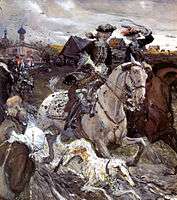 Painting by Valentin Alexandrovich Serov
Painting by Valentin Alexandrovich Serov
Notes
- ↑ "Borzoi | Define Borzoi at Dictionary.com". Dictionary.reference.com. Retrieved 2014-04-26.
- ↑ "borzoi: definition of borzoi in Oxford dictionary (British & World English)". Oxforddictionaries.com. Retrieved 2014-04-26.
- ↑ "theborzoiclub.org.uk". theborzoiclub.org.uk. Retrieved 2014-04-26.
- ↑ "Borzoi Colors and Markings". American Kennel Club. Retrieved 19 March 2012.
- ↑ "The Borzoi Standard". Borzoi Club of America. Retrieved 19 March 2012.
- ↑ At a Conformation Judges training session not long after Coren's book was released, I was greeted by the coordinator with the question, "I read something that said Borzois aren't very smart, is that true?" This to the owner of several borzois, one of which knows how to open the refrigerator, and all of which respond instantly to "commands" given in that special owner-dog private language that wouldn't even be noticed by an outsider.
- ↑ Scott pp.113
- ↑ Brunarski/Moyer. "lyric". Nktelco.net. Retrieved 23 May 2012.
- ↑ "Borzoi Club of America, Inc". Borzoiclubofamerica.org. Retrieved 23 May 2012.
- ↑ "Borzoi Temperament - What's Good About 'Em, What's Bad About 'Em". Your Purebred Puppy. Retrieved 19 March 2012.
- ↑ "NZKC - Breed Standard - Borzoi". New Zealand Kennel Club. Retrieved 3 November 2011.
- ↑ "Borzoi: Dog Breed Selector: Animal Planet". Animal Planet. Retrieved 3 November 2011.
- ↑ "Individual Breed Results for Purebred Dog Health Survey".
- ↑ Archived 14 February 2012 at the Wayback Machine.
- ↑ Glickman L, Glickman N, Schellenberg D, Raghavan M, Lee T (2000). "Non-dietary risk factors for gastric dilatation-volvulus in large and giant breed dogs". J. Am. Vet. Med. Assoc. 217 (10): 1492–9. doi:10.2460/javma.2000.217.1492. PMID 11128539.
- ↑ Scott pp.10
- ↑ Scott pp.14
- ↑ Tolstoy, Leo (2001). War and Peace. Wordsworth Classics. ISBN 1-85326-062-2.
- ↑ Fitzgerald, F. Scott (1922). The Beautiful and Damned. Serenity Publishers. pp. 91–92. Retrieved 9 May 2012.
- ↑ http://www.wordofthenerdonline.com/wp-content/uploads/2012/03/GuCu6.jpg
- ↑ "Archived copy". Archived from the original on 28 August 2007. Retrieved 2007-06-28.
- ↑ "The Borzoi Club of Queensland Inc". Borzoiclubqld.com. Retrieved 2014-04-26.
- ↑ "Mademoiselle Nobs - Pink Floyd". YouTube. Retrieved 2014-04-26.
References
- The Borzoi Handbook Winifred E. Chadwick. London: Nicholson & Watson 1952. Including a translation of The Perchino Hunt By His Excellency Dmitri Walzoff (1912).
- McRae, Gail C. (1989). Borzoi. TFH Publications; New Ed edition. pp. 191 pages. ISBN 978-0-86622-676-9.
- Martin, Nellie L. (2005). Borzoi - The Russian Wolfhound. Its History, Breeding, Exhibiting and Care. Read Books. pp. 128 pages. ISBN 978-1-84664-042-1.
- Scott, Dr. Desiree (2002). Borzoi (Pet Love). Interpet Publishing, UK. pp. 160 pages. ISBN 1-903098-93-9.
- Zotova, Galena V. (2003). Russkaya Psovaya Borzaya. Moscow. ISBN 5-94838-095-5.
External links
| Wikimedia Commons has media related to Borzoi. |